India and China have reached an agreement on the “patrolling arrangements” and the resolution of the military stand-off at the Line of Actual Control (LAC), the government announced recently.
Outcomes of the Agreement
- Resolution of 2020 issues: The agreement aims to resolve the issues that arose in 2020 and reduce military presence.
- Restoration of peace and tranquility: The agreement is intended to restore the peace and tranquility that existed before 2020.
- Monthly Meetings: Commanding officers and military commanders from both sides will meet monthly and on a case-to-case basis to manage tensions and maintain open communication.
- Troop Reduction: While patrolling will resume, both sides plan to gradually reduce the overall troop presence along the LAC, aligning with India’s winter strategy for Ladakh.
- Patrolling in previously blocked areas: Both sides have agreed to resume patrolling as it was before the 2020 stand-off.
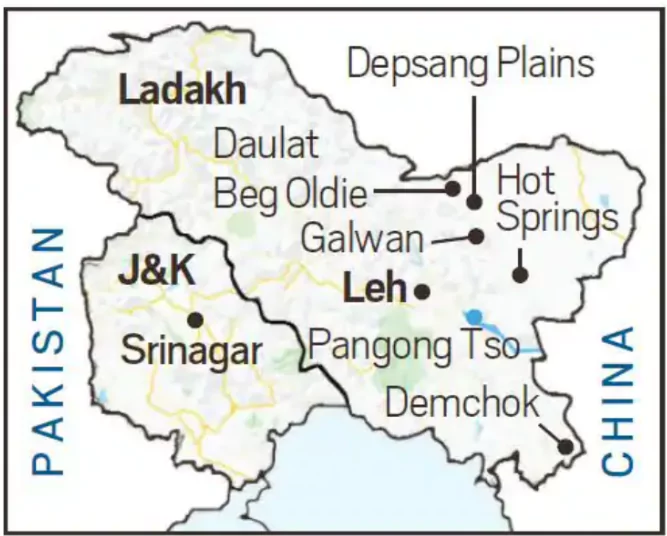 Depsang Plains: Indian troops will regain patrolling rights up to Patrolling Points (PP) 10 to 13, which were blocked by Chinese forces.
Depsang Plains: Indian troops will regain patrolling rights up to Patrolling Points (PP) 10 to 13, which were blocked by Chinese forces. - Demchok (Charding Nullah): Patrolling in this disputed area will also be restored as per the old patrolling norms along the Line of Actual Control (LAC).
- Patrolling Frequency and Coordination:
- Patrolling will occur twice a month, with at least 14-15 troops per patrol to avoid clashes.
- Both sides will exchange patrol schedules to avoid overlapping, and patrols will be coordinated to prevent face-offs.
- Shift in status quo: The agreement marks a shift in the status quo, particularly regarding the “Y junction” in the Depsang Plains.
- No Clarity on Troop Withdrawal: Although patrolling will resume, there has been no progress on de-escalation, i.e., withdrawing the thousands of troops stationed in eastern Ladakh.
Enroll now for UPSC Online Course
Strategic Importance of Depsang and Demchok
- Location: Depsang Plains are located 30 km southeast of Daulat Beg Oldie, a key military post near the Karakoram Pass.
- Flat Terrain: The plains offer flat terrain, crucial for launching potential military offensives, making control over the area highly strategic for both India and China.
- Charding Nullah: The disputed area in Demchok, where Chinese incursions occurred in 2020, holds importance for India’s border security, and the agreement to resume patrolling restores India’s access to the region.
Y-junction
- The Y-junction is a point in the Depsang Plains where a branch valley splits off to the southeast, allowing Indian patrols to reach other points on the Line of Actual Control (LAC).
- It’s also known as the bottleneck, a rocky outcrop that’s about 7 kilometres east of Burtse, where the Indian Army has a base.
- The Y-junction is a strategic area that’s close to the Daulat Beg Oldie (DBO) airstrip.
Pangong Lake
- Lake is divided between Tibet (50% under Chinese control), Ladakh (40% Indian control), and 10% disputed.
- Frequent military standoffs occur due to discrepancies in LAC perceptions.
Hot Springs (Near Gogra Post)
- Strategically significant for India due to its vantage point over LAC and surveillance of Aksai Chin.
- Helps India maintain a strong defence posture.
Galwan valley
- Narrow valley in the Karakoram mountains that’s located along the western sector of the Line of Actual Control (LAC) between China and India.
- Close to Aksai Chin, a disputed area that China controls but India claims.
|
Significance of the Agreement
- De-escalation: Signals a move towards reducing military presence along the Line of Actual Control (LAC). Restores pre-2020 patrolling norms, lowering the risk of skirmishes and escalations.
- Stabilisation: Helps stabilise the situation at friction points like Depsang Plains and Demchok.
- Reduces confrontations and fosters a conducive environment for broader negotiations on boundary issues.
- Confidence-building Measure: Restoring patrolling to pre-2020 levels indicates mutual willingness to return to a previously accepted status quo. Opens up pathways for further dialogue and trust-building.
- Political Implications: Could facilitate higher-level diplomatic engagements and improve bilateral relations outside the military domain.
- For India, it offers better management of border infrastructure without the immediate threat of conflict.
- For China, stabilising the border could reflect a strategic shift amidst other global tensions.
- Diplomatic Signals: The agreement was announced ahead of the BRICS summit in Russia, signalling a thaw in relations and the possibility of a meeting between Prime Minister Modi and President Xi Jinping.
Background of the Disputes and Stand-off

- Border Dispute: India’s border dispute with China is the most complex and longstanding one, involving an ill-defined, 3,488 km-long Border.
- The dispute stems from the legacy of British colonialism and the 1962 Sino-Indian War.
- Standoffs: The two countries have had several clashes and stand-offs along the LAC, most notably in 1967, 1987, 2013, 2017 and 2020-2021.
- Doklam: Chinese Incursion in the Doklam area in Sikkim in 2017 again ignited the border standoff between the countries. The latest conflict in the Galwan Valley in June 2020 was the first fatal confrontation between the two sides since 1975, killing at least 20 Indian soldiers.
About Doklam (Sikkim)
- It is a disputed area between China and Bhutan, and is located at the tri-junction of the three countries: India, China and Bhutan.
- Doklam is a strategically important area because it’s close to the Siliguri Corridor, which connects mainland India to its northeast region.
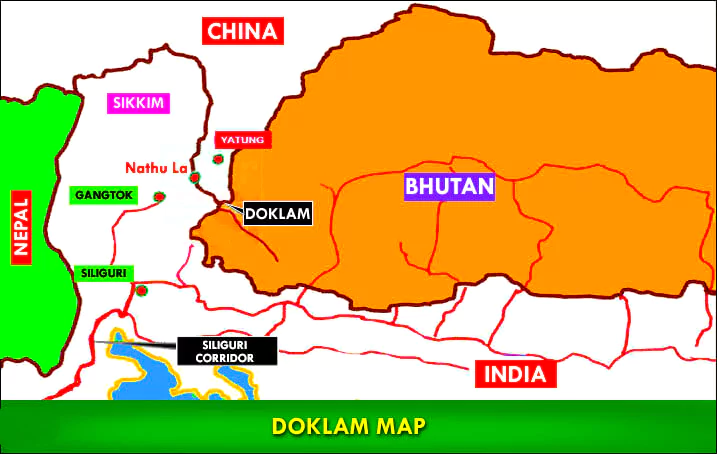
|
-
- 2020 Stand-off: The India-China military stand-off in eastern Ladakh began in April 2020.
- Friction points included Demchok, Depsang, Galwan, Pangong Tso, Gogra, and Hot Springs.
- Key Disputed Areas: The India China Border is divided into 3 sectors,
- The Western Sector: It spans across Ladakh and the Chinese-held Aksai Chin and is a 1,597 km-long LAC.
- The patrolling is done till 65 earmarked Patrol Points (PPs) stretching from Karakoram to Chumur.
- The Central Sector: It Spans across Himachal Pradesh and Uttarakhand with length 545 Km and is the least contentious area between the 2 countries but consists of certain flashpoints like Tashigang-Shipki La in Himachal, Sang-Nelang-Pulam Sumda and Barahoti in Uttarakhand.
- The Eastern Sector: It comprises sites such as Namkha Chu, Sumdorong Chu, Fish Tail 1 and Dibang valley in Sikkim and Arunachal Pradesh with length 1346 Kms.
- Although China claims the entire Arunachal Pradesh Territory as its integral part.
Check Out UPSC CSE Books From PW Store
Reasons for the India-China Border Dispute
- Ambiguity in the Definition of the LAC: India and China have differing perceptions of the Line of Actual Control (LAC), leading to frequent confrontations.
- In the 2020 stand-off, China moved into areas in eastern Ladakh, including the Galwan Valley and Pangong Tso, where the LAC is disputed.
- Historical Legacy of the 1962 Sino-Indian War: The unresolved border disputes from the 1962 war over territories like Aksai Chin and Arunachal Pradesh remain a source of tension.
- China controls Aksai Chin (claimed by India as part of Ladakh), while India controls Arunachal Pradesh, which China claims as “South Tibet.”
- Infrastructure Development by India: India’s rapid development of infrastructure, including roads, airstrips, and bridges, in border areas has alarmed China.
- The completion of the Darbuk-Shyok-Daulat Beg Oldie (DSDBO) Road increased India’s access to the sensitive LAC region, prompting Chinese aggression in Depsang Plains.
- Strategic Importance of Border Areas: Both countries view key regions near the LAC as strategically vital, creating territorial competition.
- The Depsang Plains near Daulat Beg Oldie is of strategic importance due to its proximity to the Karakoram Pass, a potential military launch point.
- China’s “Salami-Slicing” Tactics: China’s gradual territorial encroachments in disputed areas seek to shift the status quo without provoking outright conflict.
- In 2020, Chinese troops advanced in Pangong Tso Lake, altering the ground situation by occupying previously uncontested Finger areas (Finger 4 to Finger 8).
- Differing Border Claims and Maps: The two sides rely on different historical maps and agreements, creating conflicting territorial claims.
- China uses its interpretation of historical maps to justify its claim over Arunachal Pradesh and Aksai Chin.
- Strategic Rivalry and Geopolitical Tensions: The broader geopolitical rivalry between China and India, especially with India’s growing ties to the U.S. and participation in alliances like the Quad, intensifies border tensions.
- China’s 2020 aggression in Ladakh coincided with increasing Indian engagement with the Quad (India, U.S., Japan, Australia), seen as a challenge to China’s dominance in the Indo-Pacific.
- Internal Security Concerns for China: China wants to secure its borders in Tibet and Xinjiang to prevent unrest or external influence.
- Legacy of Unresolved Agreements: The 1993 and 1996 border agreements aimed at maintaining peace have not been able to resolve the fundamental disputes, leading to periodic confrontations.
- Buffer Zones and Military Presence: The establishment of buffer zones in disengaged areas has led to disagreements over patrolling and access rights.
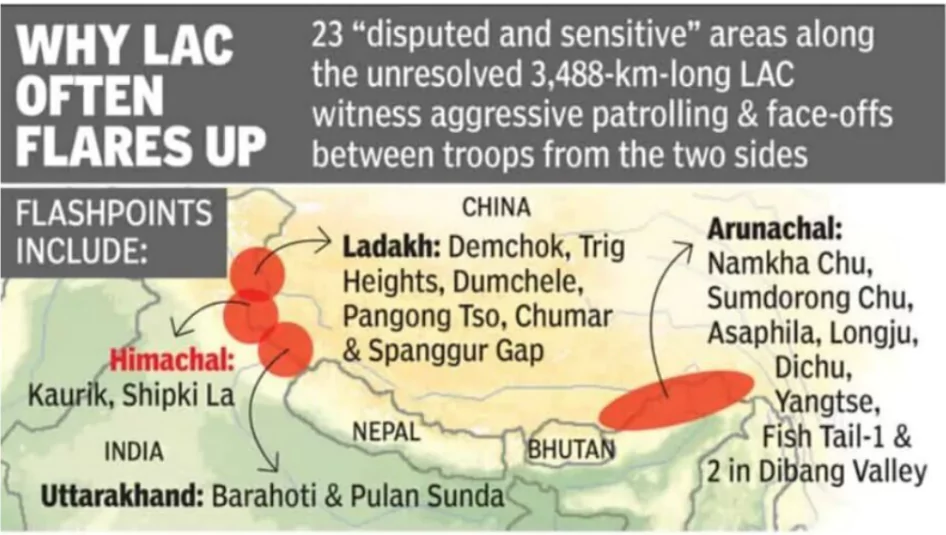
Earlier Efforts to Resolve the India-China Dispute
- Shimla Agreement (1914): A convention held to demarcate the boundary between Tibet and North-East India. Signed by British India and Tibet, but China refused to accept it.
- India recognizes the agreement and the McMahon Line, but China rejects both.
- Panchsheel Agreement (1954): Established the principles of peaceful coexistence, including respecting sovereignty and territorial integrity.
- Initially accepted by China, but the agreement’s spirit was violated during the Sino-Indian War of 1962.
- Agreement on the Maintenance of Peace and Tranquility (1993): Aimed at recognizing the Line of Actual Control (LAC) and renouncing the use of force.
- Provided a framework for negotiations to resolve border issues. Despite this, tensions along the LAC continued.
- Agreement on Confidence Building Measures (1996): Focused on non-aggression, communication, and notification of troop movements near the border.
- Both countries agreed to exchange maps to resolve LAC disagreements and prevent accidental military escalations.
- Border Defence Cooperation Agreement (BDCA, 2013): Signed after the Depsang Valley incident, it aimed to prevent such face-offs in the future. Focused on enhancing mutual understanding and managing border-related issues.
- Despite this, incidents and tensions along the border have continued, but the BDCA remains crucial for maintaining dialogue.
Challenges Associated with India China Relations
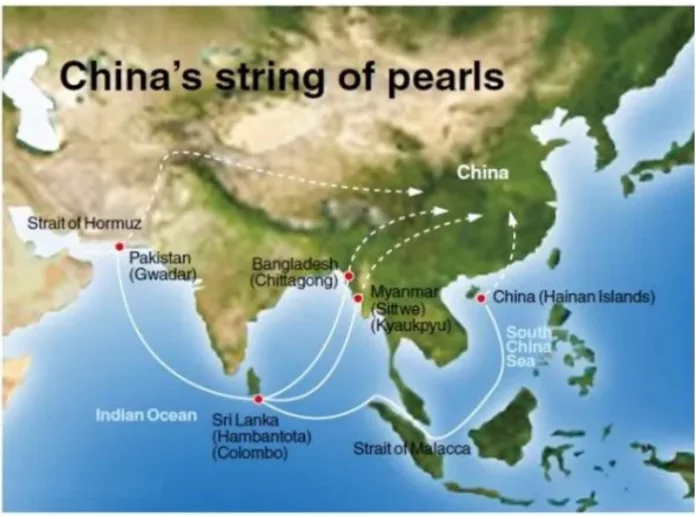
- Five Finger Policy: China views Tibet as its “palm,” with Ladakh, Nepal, Sikkim, Bhutan, and Arunachal Pradesh as its “fingers,” claiming influence over these regions.
- Both nations maintain large troop deployments along the 3,488 km-long Border, especially in eastern Ladakh.
- Salami Slicing Strategy: China uses incremental territorial advancements, building infrastructure like roads and villages along the border to gradually change the status quo. Example: Construction of 628 dual-use villages along the India-Tibet border.
- Belt and Road Initiative (BRI): India opposes China’s BRI, particularly the China-Pakistan Economic Corridor (CPEC), which passes through Pakistan-occupied Kashmir, violating India’s territorial integrity.
- Aggressive Neighborhood Policies: China’s “String of Pearls” strategy includes building ports and naval facilities to encircle and exert influence over India’s maritime routes. Ex: The Hambantota port in Sri Lanka.
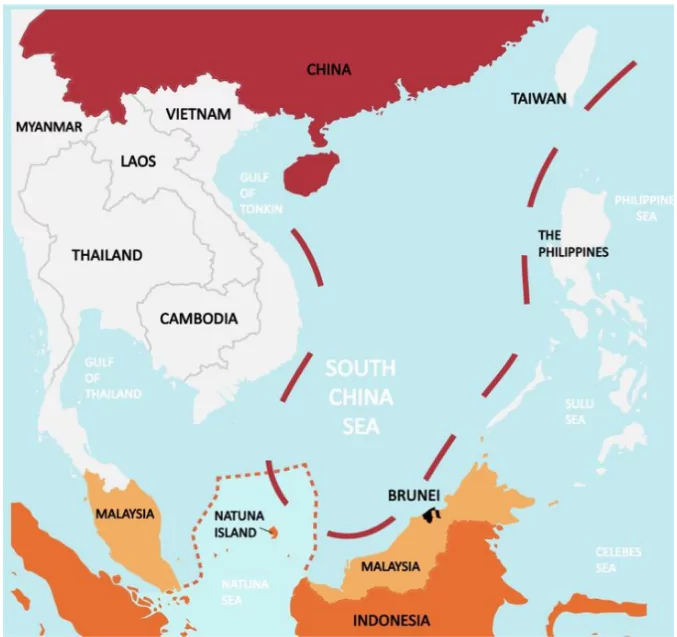 Debt Trap Diplomacy: China uses loans to gain strategic control over nations, affecting India’s relationships in South Asia, like Maldives and Sri Lanka, which increases China’s influence and undermines India’s “Neighborhood First” policy.
Debt Trap Diplomacy: China uses loans to gain strategic control over nations, affecting India’s relationships in South Asia, like Maldives and Sri Lanka, which increases China’s influence and undermines India’s “Neighborhood First” policy.- India’s Import Dependency: India has a large trade deficit with China, with imports totaling USD 83.2 billion in 2022-23, heavily reliant on China for essential goods like pharmaceutical raw materials (KSM).
- Water Dispute: No treaty governs the sharing of the Brahmaputra River, creating tension as China constructs dams upstream, which impacts India’s water resources.
- South China Sea (SCS) Conflict: China’s aggressive claims in the South China Sea, through the “Nine-Dash Line” and militarization of artificial islands, create tensions with India’s maritime interests, especially in Vietnam’s invitation to India for oil and gas exploration.
Check Out UPSC NCERT Textbooks From PW Store
Indian Efforts to Counter Chinese Influence
- Strategic Global Alliances: India actively collaborates with like-minded nations to collectively address China’s growing influence in the Indian Ocean Region.
- Initiatives such as the QUAD and I2U2 focus on securing maritime routes and bolstering India’s geo political stance.
- QUAD:
- Established in 2007, re-established in 2017.
- Members: United States, Japan, Australia, and India.
- Aim: To keep the strategic sea routes in the Indo-Pacific free of any military or political influence. It is basically seen as a strategic grouping to reduce Chinese domination.
- I2U2 (India, Israel, the UAE, and the US):
- I2U2 is also referred to as the ‘West Asian Quad’.
- Aims: To discuss “common areas of mutual interest, to strengthen the economic partnership in trade and investment in respective regions and beyond”.
- INSTC (International North South Trade Corridor)
- INSTC was initiated in 2000 by Russia, India and Iran.
- It is a multi-modal transportation route linking the Indian Ocean and the Persian Gulf to the Caspian Sea via Iran, and onward to northern Europe via St Petersburg in Russia.
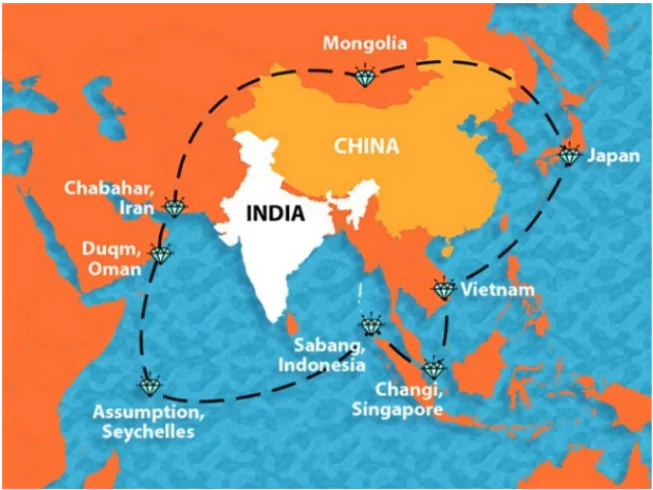 IMEC (India Middle East Europe Economic Corridor): IMEC (India Middle East Europe Economic Corridor): -
- IMEC Corridor offers multi-modal connectivity from India to Europe, potentially reducing transit time and costs.
- Necklace of Diamonds Strategy: India’s response to China’s “String of Pearls” involves strengthening naval bases, building military alliances, and enhancing its maritime presence to secure the Indo-Pacific and Indian Ocean regions.
- Enhanced Border Infrastructure: India has accelerated border infrastructure development to solidify its defence along the India-China border.
- The Border Roads Organisation (BRO) completed 90 key projects, particularly in regions like Arunachal Pradesh, Ladakh, and Jammu & Kashmir, improving strategic connectivity.
- Strengthening Ties with Neighbors: India focuses on fostering strong regional partnerships to counter China’s influence in South Asia.
- Recent collaborations with Bhutan (Gelephu mindfulness city) and Nepal (power agreements and cross-border energy projects) highlight India’s efforts to ensure regional stability.
- India and Nepal have agreed to export 10,000 MW of power over the next decade, alongside inaugurating new cross-border transmission lines, furthering regional collaboration.
|
Way Forward to India-China Relations
- Border Disputes Resolution: Establish additional buffer zones in contested areas, building on existing border protocols, particularly the ban on firearms.
- Regular high-level dialogue and mutual agreement on military deployments near the border, focusing on “mutual and equal security.“
- Economic Cooperation: Address trade imbalance by diversifying imports and facilitating alternate global supply chains. Explore a Free Trade Agreement (FTA) to enhance India’s exports to China.
- Conflict Prevention and Crisis Management: Strengthen military deterrence in the mountains and Indian Ocean, countering Chinese gray zone threats.
- Deploy ITBP, bolster border security with Rafale jets, and conduct joint military exercises.
- Cultural Diplomacy: Promote people-to-people exchanges through student programs, cultural festivals, and joint research projects.Initiate language exchange programs to build trust between citizens of both nations.
- Track One diplomacy refers to formal negotiations between nations conducted by professional diplomats.
- Track Two diplomacy refers to conflict resolution efforts by professional non-governmental conflict resolution practitioners.
|
- Track Diplomacy: Encourage Track Two diplomacy through non-governmental initiatives to foster dialogue and build a “trust society.”
- Vibrant Villages Programme: Implement the development of villages in bordering states (Ladakh, Himachal Pradesh, Uttarakhand, Sikkim, Arunachal Pradesh) to improve connectivity and security.
- Replicating ANC Model: Expand the Andaman and Nicobar Command’s (ANC) integrated approach to other regions, contributing to Indo-Pacific security in response to China’s rising influence.
Enroll now for UPSC Online Classes
Conclusion
The recent agreement between India and China marks a significant breakthrough in resolving the military stand-off along the LAC, particularly in friction areas like Demchok and Depsang. Patrolling is set to resume as it was before 2020, although details on de-escalation and future steps are still being worked out.
![]() 22 Oct 2024
22 Oct 2024
 Depsang Plains: Indian troops will regain patrolling rights up to Patrolling Points (PP) 10 to 13, which were blocked by Chinese forces.
Depsang Plains: Indian troops will regain patrolling rights up to Patrolling Points (PP) 10 to 13, which were blocked by Chinese forces. 


 Debt Trap Diplomacy: China uses loans to gain strategic control over nations, affecting India’s relationships in South Asia, like Maldives and Sri Lanka, which increases China’s influence and undermines India’s “Neighborhood First” policy.
Debt Trap Diplomacy: China uses loans to gain strategic control over nations, affecting India’s relationships in South Asia, like Maldives and Sri Lanka, which increases China’s influence and undermines India’s “Neighborhood First” policy.